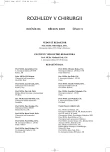Crossectomy Doesn’t Improve Outcome of Endovenous Laser Ablation of Varicose Veins
Authors:
S. Kašpar; J. Šiller
Authors‘ workplace:
Chirurgická klinika Krajské nemocnice Pardubice, přednosta: doc. MUDr. K. Havlíček, CSc.
; Fakulta zdravotnických studií Univerzity Pardubice, děkan: prof. MUDr. A. Pellant, DrSc.
Published in:
Rozhl. Chir., 2007, roč. 86, č. 3, s. 144-149.
Category:
Monothematic special - Original
Overview
Aims:
Crossectomy (extended saphenofemoral or saphenopopliteal junction ligation) and stripping of refluxing saphenous trunk represent the basis of the traditional surgical therapy of varicose veins. Endovascular techniques of saphenous ablation are the mini- invasive alternatives of the radical surgical treatment. The objective of this study is the comparison of the endovenous laser ablation with and without crossectomy through open groin access.
Material and Methods:
Retroprospective study compares the results of the group of patients treated with simple endovenous laser ablation (HVL – 329 limbs) and HVL completed with crossectomy (35 limbs). Both groups were comparable in terms of basic demographic and preoperative clinical data (p > 0.05). In both cohorts, subgroups with identical laser parameters were selected (p > 0.05). All procedures were performed according the same standard protocol, EVL patients received LMWH in the postoperative period. The results were evaluated by the comparison of CEAP clinical class pre and postoperatively, the percentage of recanalizations and also using the Kaplan-Meier life-table method.
Results:
No thrombosis, nor pulmonary embolism were diagnosed in the post-operative period. During the follow-up (98% treated limbs), venous occlusion was observed in 88% of them (91.05 % in the endovenous group and 65.71 % in the combined group). These differences are not statistically significant (p = 0.24). Same results were found using the Kaplan-Meier method (p = 0.086).Treatment significantly reduced CEAP clinical class in both groups but the results are better (C = 0.41 vs. 0.8) in the endovenous group (p = 0.004).
Conclusions:
Endovenous ablation of the refluxing saphenous vein represents good alternative of crossectomy and stripping. Combination of both procedures is not effective and, on the contrary, can cause short and long-term complications.
Key words:
crossectomy – stripping – endovenous laser – CEAP – saphenous ablation
Sources
1. Abu-Own, A., Scurr, J. H., Coleridge-Smith, P. D. Saphenous vein reflux without incompetence at the saphenofemoral junction. Br. J. Surg., 1994; 81: 1452–1454.
2. Hollingsworth, S. J., Tang, C. B., Barker, S. G. E. Primary varicose veins in the presence of an intact sapheno-femoral junction. Phlebology, 2001; 16: 68–72.
3. Pichot, O., Sessa, C, Bosson, J.-L., et al. Duplex imaging analysis of the long saphenous vein reflux: basis for strategy of endovenous obliteration treatment. Int. Angiol., 2002; 21: 333–336.
4. Chang, C. J., Chua, J. J. Endovenous laser photocoagulation (EVLP) for varicose veins. Lasers Surg. Med., 2002; 31; 257–262.
5. Foldyna, A., Lajmar, K., Matoušek, P. Naše zkušenosti s laserovou fotokoagulací křečových žil. Rozhl. Chir., 2003; 82: 365–367.
6. Corcos, L., Dini, S., De Anna, D., Marangoni, O., Ferlaino, E., Procacci,T., Spina, T., Dini, M. The immediate effects of endovenous diode 808-nm laser in the greater saphenous vein: morphologic study and clinical implications. J. Vasc. Surg., 2005; 41 (6): 1018–1024.
7. Chandler, J. G., Pichot, O., Sessa, C., et al. Defining the role of extended saphenofemoral junction ligation: a prospective comparative study. J. Vasc. Surg., 2000; 32: 941–953.
8. Kašpar, S., Havlíček, K. Endovaskulární léčba kmenových varixů dolních končetin. Rozhl. Chir., 2004; 83: 96–101.
9. Muller, R. Traitement des varices par la phlébectomie ambulatoire. Bull. Soc. Fr. Phléb., 1966; 19: 277–279.
10. Eklof, B. Modem treatment of varicose veins. Br. J. Surg., 1988; 75: 297–298.
11. Veverková, L., Růžička, M., Kalač, J. Relations of the long saphnenous vein and saphenous nerve from the point of view of varicose vein surgery. Phlebology, 1995; 1: 48–51.
12. Sheppard, H. A procedure for the prevention of recurrent saphenofemoral incompetence. Aust. N Z J. Surg., 1978; 48: 322–326.
13. Royle, J. P. Recurrent varicose veins. World J. Surg., 1986; 10: 944–958.
14. Pepper, M. S. Positive and negative regulation of angiogenesis: from cell biology to the clinic. Vasc. Med., 1996; 1 (4): 259–266.
15. Reček, C, Pojer, H. Ambulatory pressure gradient in the veins of the lower extremity. Vasa, 2000; 29(3): 187–190.
16. Reček, C. Principy chirurgického léčení varixů konfrontované snovými poznatky o žilní hemodynamice. Rozhl. Chir. 2002; 81(9): 484–491.
17. Glass, G. M. Neovascularisation in recurrent saphenofemoral incompetence of varicose veins. Surgical anatomy and morphology. Phlebology, 1995; 10: 136–142.
18. Navarro, L., Min, R., Bone, C. Endovenous laser: a new minimally invasive method of treatment for varicose veins. Preliminary observation using a 810nm diode laser. Dermatol. Surg., 2001; 27: 117–122.
Labels
Surgery Orthopaedics Trauma surgeryArticle was published in
Perspectives in Surgery

2007 Issue 3
Most read in this issue
- Lung Sequestration as an Accidental Finding in Adulthood. Surgical Therapy
- Partial Mastectomy vs. Breast Ablation in Treatment of Invasive Lobulary Carcinoma
- Reconstruction of Soft Tissue Defects of Lower Leg, Ankle and Foot using Sural Flap
- Crossectomy Doesn’t Improve Outcome of Endovenous Laser Ablation of Varicose Veins
